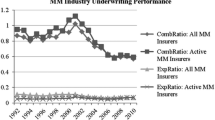Abstract
We study underwriting relationships in the floating rate debt market, where many issuers have a large number of offerings. We find that frequent issuers maintain close relationship with only three to five underwriters and pay significantly less underwriting fees than infrequent issuers. The findings are consistent with the notion that starting an underwriting relationship requires expenses for information production. We also find that an issuer’s first underwriter has a cost advantage over later-comers in competing for the issuer’s business. As a result, the first underwriter wins a larger share of the issuer’s business.
Similar content being viewed by others
References
Altinkilic O, Hansen R (2000) Are there economies of scale in underwriting fees? Evidence of rising external financing costs. Review of Financial Studies 13:191–218
Ang J, Zhang S (2004) League table: A study of the competition to underwrite floating rate debt. Journal of International Financial Markets, Institutions and Money 14:329–349
Beatty R, Ritter J (1986) Investment banking, reputation, and the underpricing of initial public offerings. Journal of Financial Economics 15:213–232
Booth J, Smith R (1986) capital raising, underwriting and the certification hypothesis. Journal of Financial Economics 15:261–281
Burch T, Nanda V Warther V (2005) Does it pay to be loyal? An empirical analysis of underwriting relationships and fees. Journal of Financial Economics 77:673–699
Carter RF, Manaster S (1990) Initial public offerings and underwriter reputation. Journal of Finance 45:1045–1067
Chemmanur TJ, Fulghieri P (1994) Investment bank reputation, information, production, and financial intermediation. Journal of Finance 49:57–80
Chen H, Ritter J (2000) The seven percent solution. Journal of Finance 55:1105–1132
Ederington L (1975) Uncertainty, competition, and costs incorporate bond underwriting. Journal of Financial Economics 2:71–94
Ederington L (1978) Bidding for securities: The effect on the issuer’s interest costs. Journal of Business 51:673–686
Fernando C, Gatchev V, Spindt P (2005) Wanna dance? How dirms and underwriters choose each other. Journal of Finance 60:2437–2469
Foster D (1989) Syndicate size, spreads and market power during the introduction of shelf registration. Journal of Finance 44:195–204
Gande A, Puri M, Saunders A (1999) Bank entry, competition, and the market for corporate securities underwriting. Journal of Financial Economics 54:165–197
Hansen R, Pinkerton J (1982) Direct equity financing: a resolution of a paradox. Journal of Finance 37:651–665
Hansen R, Torregrosa P (1992) Underwriter compensation and corporate monitoring. Journal of Finance 47:1537–1555
James C (1992) Relationship-specific assets and the pricing of underwriter services. Journal of Finance 47:1865–1885
Kidwell D, Marr W, Thompson R (1984) SEC rule 415: The ultimate competitive bid. Journal of Financial and Quantitative Analysis 19:183–195
Krigman L, Shaw W, Womack K (2001) Why do firms switch underwriters?. Journal of Financial Economics 60:245–284
Merton R (1987) A simple model of capital market equilibrium with incomplete information. Journal of Finance 42:483–510
Rogowski R, Sorenson E (1985) Deregulation in investing banking: shelf registrations, structure and performance. Financial Management 14:5–15
Roten I, Mullineaux D (2002) Debt underwriting by commercial bank-affiliated firms and investment banks: more evidence. Journal of Banking and Finance 26:689–718
Saunders A, Srinivasan A (2001) Investment banking relationships and merger fees. Unpublished Working Paper, New York University
Tufano P (1989) Financial innovation and first-mover advantages. Journal of Financial Economics 25:213–240
Ugeux G. (1985) Floating rate notes. Euromoney Publications Limited, London
Author information
Authors and Affiliations
Corresponding author
Additional information
JEL Classification G21 · G24
Rights and permissions
About this article
Cite this article
Ang, J.S., Zhang, S. Underwriting relationships: Information production costs, underwriting fees, and first mover advantage. Rev Quant Finan Acc 27, 205–229 (2006). https://doi.org/10.1007/s11156-006-8796-1
Issue Date:
DOI: https://doi.org/10.1007/s11156-006-8796-1



